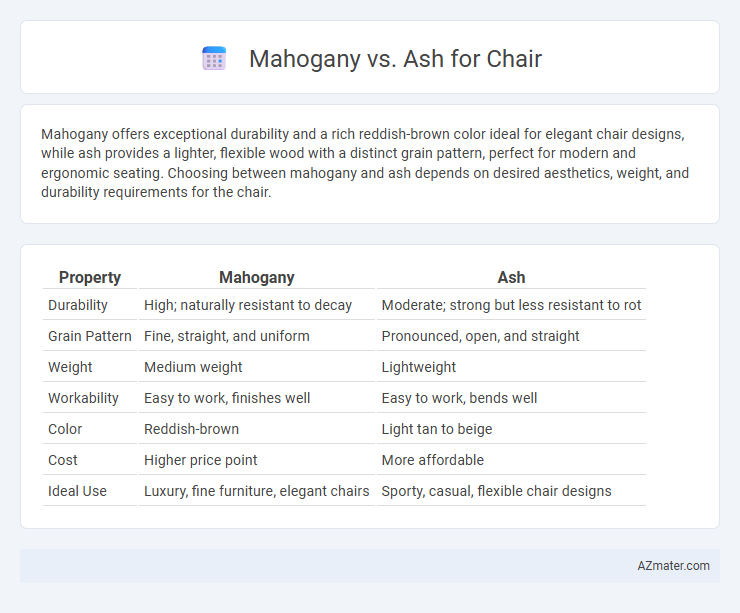Mahogany offers exceptional durability and a rich reddish-brown color ideal for elegant chair designs, while ash provides a lighter, flexible wood with a distinct grain pattern, perfect for modern and ergonomic seating. Choosing between mahogany and ash depends on desired aesthetics, weight, and durability requirements for the chair.
Table of Comparison
| Property | Mahogany | Ash |
|---|---|---|
| Durability | High; naturally resistant to decay | Moderate; strong but less resistant to rot |
| Grain Pattern | Fine, straight, and uniform | Pronounced, open, and straight |
| Weight | Medium weight | Lightweight |
| Workability | Easy to work, finishes well | Easy to work, bends well |
| Color | Reddish-brown | Light tan to beige |
| Cost | Higher price point | More affordable |
| Ideal Use | Luxury, fine furniture, elegant chairs | Sporty, casual, flexible chair designs |
Introduction to Mahogany and Ash as Chair Materials
Mahogany offers exceptional durability and a rich reddish-brown hue, making it a popular choice for high-end chairs that require both strength and elegance. Ash is prized for its light color, flexibility, and excellent shock resistance, ideal for chairs designed with ergonomic comfort and modern aesthetics in mind. Both woods provide unique grain patterns and robust structural qualities that enhance chair longevity and visual appeal.
Overview of Mahogany Wood Properties
Mahogany wood is prized for its rich reddish-brown color, fine grain, and exceptional durability, making it a top choice for chair construction. It offers excellent resistance to rot and insect damage, contributing to long-lasting furniture pieces. Its smooth texture and stability ensure comfortable seating and an elegant finish that ages beautifully over time.
Key Characteristics of Ash Wood
Ash wood, known for its light color and straight grain, offers excellent strength and flexibility, making it a popular choice for chair manufacturing. Its high shock resistance and durability provide long-lasting comfort and stability, while the open grain texture gives a smooth finish that is easy to stain or paint. Compared to mahogany, ash tends to be more affordable and sustainable, appealing to eco-conscious consumers seeking both performance and aesthetics in furniture.
Durability Comparison: Mahogany vs Ash
Mahogany offers superior durability for chairs due to its dense, tight grain structure and natural resistance to rot and insects, making it ideal for long-lasting furniture. Ash, while slightly less dense, provides excellent shock resistance and flexibility, which enhances its durability under stress and frequent use. Both woods are durable, but mahogany's hardness and stability give it an edge for high-quality, enduring chair construction.
Aesthetic Differences: Color and Grain Patterns
Mahogany chairs exhibit rich, reddish-brown tones with a smooth, consistent grain that enhances elegance and warmth. Ash chairs feature lighter, pale beige to light brown hues with prominent, straight grain patterns that offer a more rustic and airy appearance. The choice between mahogany and ash significantly impacts the chair's aesthetic, influencing the overall ambiance from classic sophistication to casual brightness.
Comfort and Ergonomics in Mahogany vs Ash Chairs
Mahogany chairs offer superior comfort due to their dense grain structure, which provides enhanced durability and support for prolonged seating. Ash chairs excel in ergonomics with their natural flexibility and lightweight properties, allowing for better contouring to the body and reduced strain during extended use. Both woods contribute distinct advantages, where mahogany guarantees solid support and ash promotes adaptive comfort through its elastic characteristics.
Weight and Workability for Chair Construction
Mahogany is heavier and denser than ash, making it more durable but harder to handle during chair construction. Ash offers excellent workability with a lighter weight, allowing for easier shaping and assembly while still providing strong structural integrity. Choosing mahogany prioritizes strength and richness, whereas ash is favored for flexibility and reduced chair weight.
Cost and Availability of Mahogany and Ash
Mahogany chairs tend to be more expensive due to the wood's rarity and slower growth rate, making it less readily available in the market. Ash, commonly found in North America and Europe, offers a more affordable and widely accessible alternative for chair manufacturing. The cost difference is significant, with ash priced lower because of its abundance and faster replenishment compared to mahogany's premium status.
Sustainability and Environmental Impact
Mahogany offers durability and a rich aesthetic but is often sourced from tropical forests, raising concerns about deforestation and habitat loss if not certified by organizations like FSC. Ash, being more abundant and fast-growing, provides a renewable option with a lower environmental footprint, especially when harvested sustainably from managed North American forests. Choosing ash supports sustainable forestry practices and reduces the carbon impact compared to rare and slow-growing mahogany.
Which is Better for Chairs: Mahogany or Ash?
Mahogany offers rich, deep color and exceptional durability, making it ideal for elegant, long-lasting chairs with a smooth finish and resistance to wear. Ash provides a lighter, more flexible wood with impressive shock resistance and a striking grain pattern, perfect for contemporary or rustic-style chairs requiring strength and elasticity. Choosing between mahogany and ash depends on the desired aesthetic and functional balance: mahogany excels in luxury and permanence, while ash combines robustness with a brighter, natural look.

Infographic: Mahogany vs Ash for Chair
 azmater.com
azmater.com